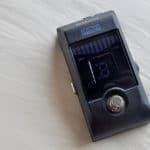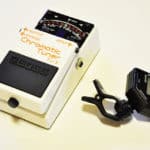Tuning a guitar is pivotal for making it sound good.
After all, playing an out-of-tune guitar is a nightmare for the audience’s ears. Better not to play at all!
Luckily, electric tuners are so useful that we don’t need to worry about these problems.
We might not have to dwell on this problem nowadays, but what happened in the past?
Electronic tuners didn’t exist, so how did musicians tune their instruments properly?
Before electronic tuners, guitarists tuned their instruments either by ear or with a tuning fork. These alternatives, however, are still used by hundreds of guitarists around the world. They are not the most popular method, but they are definitely effective enough.
There is a lot of interesting information regarding this topic.
I assure you don’t want to miss out on any of these.
With that being said, let’s discuss this information in a more detailed way.
When were electronic guitar tuners invented?
It seems that electronic guitar tuners are a relatively new addition to the world of music.
Surprisingly, the very first tuner dates back to 1936! That’s older than the first mass-produced electric bass guitar!
Although the first modern bass guitar was made in 1935, the Fender bass hit the market in the 40s. This is a fascinating fact because it means that electronic tuners have been around for almost 90 years by the time of publishing this article.
In a bit more than a decade, the electronic guitar tuner will have 100 years old!
This tuner was known as the Stroboconn (or Strobe tuner) and was developed by Conn.
Nowadays, these tuners are nothing but museum jewels for collectors and historians. They are not available in the market since they are rather outdated for contemporary standards.
Nonetheless, they were pivotal for our modern electronic tuners and tuning apps.
How did people tune their guitars before electronic tuners?
Although electronic tuners are an effective tool, they are not the only form of tuning a guitar.
After all, tuners have been around for various decades, but guitars have been around longer, since the fourteen or fifteen century!
So, you wouldn’t expect a guitar player from the 1600s to ask for an electronic tuner.
“Hey bro, could you lend me the electronic tuner? I have a gig tonight” Just to receive his friend’s answer: “What the hell does electronic mean???”
Of course, playing out of tune was neither an option. So, which were the alternatives?
First of all, many musicians used to tune by ear. Naturally, this practice is still being done by modern players.
After all, tuning by ear is not impossible. It is a hard task, and it takes some practice, but in the end, you can accomplish it.
All in all, it is nothing but a habit that can be developed by any musician. All you have to do is keep playing until you get familiarized with the proper tones.
Also, before electronic tuners, anyone would tune their instruments based on how the rest of the notes sounded.
To be more specific, the guitarists would play a chord, or an isolated note and its octave, and then compare the quality of its music.
If the notes were feeling off, then that was a clear sign the tuning was not appropriate. Needless to say, this practice can still be done nowadays.
Lastly, guitarists tuned their instruments with a tuning fork, a tool that dates back to 1711.
The tuning fork is a piece of metal that, when struck with an object, resonates and vibrates at a specific pitch.
Some old-school-oriented musicians still use tuning forks, which is a rather interesting form of tuning a guitar.
Are electronic tuners more accurate than the classic methods?
It is safe to say that electronic tuners are the most accurate tuning method of them all.
In any case, it could probably be replaced by the tuning fork, which is very efficient.
Now, if we compare an electronic tuner with tuning by ear, then the tuner wins.
Some guitarists have absolute pitch, so they may tune a guitar 100 percent accurately.
On the other hand, tuners are never precise. The result seen on the screen of the tuner is an approximation of the note.
Of course, this approximation is so close to the exact pitch that most people don’t notice the difference.
Plus, most guitarists don’t have absolute pitch. Even if their hearing skills are sharp and they learn songs by ear, that doesn’t mean that, if they tune a guitar by ear, the result will be perfect.
So, in the end, electronic tuners are the best option. However, we encourage you to, little by little, get used to tuning by ear.
It will pay off in the long run.
Why did electronic tuners prevail?
Tuners prevail because of their effectiveness and convenience.
It is rather comfortable to have an electronic tuner. You may take it with you to rehearsals, live performances, or jam sessions with your friends, and it will always be useful.
While tuning by ear is possible, there will be times in which you’ll need to tune your instrument as fast as you can.
In those situations, a tuner will come in handy.
Plus, tuners are neither too big nor too expensive. Purchasing one would not mean a huge waste of money, and once you have one, you can take it with you anywhere since they fit in any guitar case’s pocket.
Not to mention, it is possible to carry a tuner within your cellphone! If that’s not convenient, then I don’t know what it is.
Also, do not forget their efficiency. An electronic tuner is, in most cases, the most accurate approach to perfect tuning.
All in all, these devices are so precise that it is almost illogical to think about new guitarists without one.
Do people still tune their guitars with any of the classic methods?
It is not a surprise to see young guitarists choosing the old-schooled tuning methods.
We have already stated the relevance of tuning by ear: it sharpens your hearing skills, and it is useful whenever you can’t find a tuner.
But other than that, many believe that tuning by ear is even faster. This might be true since, in certain circumstances, an approximate tuning will be enough for playing.
For example, let’s say you are with your friends at a camp. Someone approaches you with an acoustic guitar and asks you to play some classics.
However, the guitar is too out of tune. Instead of taking out a tuner, all you need to do is find a tuning that sounds as accurate as possible.
Then, simply play and have fun.
Lastly, the alternatives are great for instruments with intonation issues, and those whose tunings are other than 440hz.
To sum up, it all depends on the musicians’ preferences.
Find the one that suits you best. If it works, then that’s all you need.

Hello there, my name is Ramiro and I’ve been playing guitar for almost 20 years. I’m obsessed with everything gear-related and I thought it might be worth sharing it. From guitars, pedals, amps, and synths to studio gear and production tips, I hope you find what I post here useful, and I’ll try my best to keep it entertaining also.





